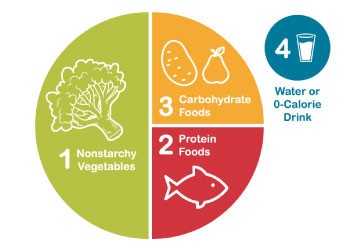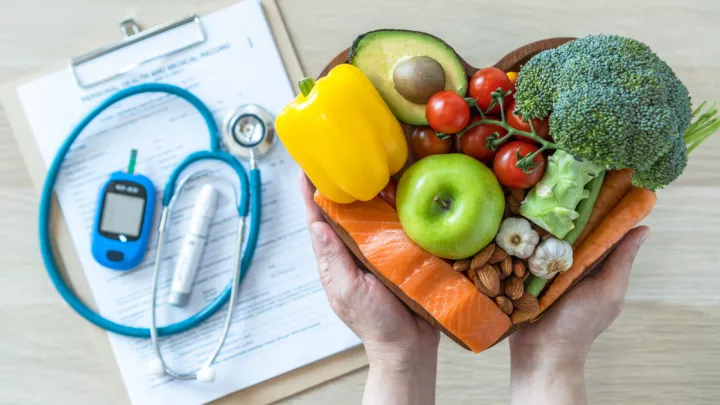Diabetic diet: Dos, don'ts and meal plans to try

If you have diabetes or are pre-diabetic, your doctor may have talked to you about your diet. While there is no one-size-fits-all "diabetic diet", making certain changes to the way you eat can help to reduce blood sugar levels, lower blood pressure and improve your cholesterol levels – all of which can help reduce your risk of future heart disease.
So, if there's not a specific diabetes meal plan to follow, how do you know what (and how much) to eat to meet your goals?
The best advice is to work with your doctor, dietician or diabetes educator to create a diet plan just for you. However, if you're ready to start making some positive changes to your diet today, endocrinologist Clifton Davis, MD, offers the following advice.
Top 5 tips for a healthy diabetic diet
- Replace sugary beverages (like soda or juice) with water.
- Avoid snacking in between meals and before bedtime.
- Increase your intake of fruits, whole grains, beans, low-fat dairy, and non-starchy vegetables such as lettuce, cucumbers, tomatoes and broccoli.
- Be carb-conscious when making food choices by reading food labels and using online carbohydrate calculators.
- Limit processed or refined foods like pasta, white bread, white rice and cereals.
Fruit, soda and other tricky foods
You might be wondering if it's OK to eat foods containing natural sugars, like bananas or strawberries, if you're a person with diabetes. "Some fruit is higher in sugar than others," explains Dr. Davis. "The key is knowing the appropriate serving size for the type of fruit you're eating."
For example, one serving of carbohydrates is 15 grams, which is equal to:
- 1 small apple
- 1/2 of a banana
- 15 grapes
- 1 cup of strawberries
When it comes to drinks, water is the best substitute for regular soda and other sugary beverages. While diet soda is a lower calorie and lower carbohydrate alternative to regular soda, it should still be consumed in moderation.
"If you must have your caffeine fix, black coffee generally has less of an impact on blood sugar levels, but it can affect people differently," explains Dr. Davis. "You should also avoid adding dairy and sweeteners as these can affect your blood sugar."
Finally, if you follow a vegetarian or vegan diet, make sure you're eating enough protein. Dr. Davis also recommends not eating too many simple carbohydrates like potatoes, pasta and white rice. Doing so will help keep your blood sugar levels in check on a vegetarian diet.
Are low-carb diets good for those with diabetes?
Although low-carb and keto diets are popular right now, Dr. Davis recommends working with your doctor, as well as a dietician or diabetes educator, to create an individualized diet plan if you have Type 2 diabetes. "Also, very low-carb diets aren't recommended if you have kidney disease, or are pregnant or breastfeeding," he adds.
According to the American Diabetes Association, a low-carb diet can provide some benefits to people with diabetes. However, you should work closely with your doctor and a registered dietitian nutritionist to help minimize risks like hypoglycemia.
In general, anyone who has diabetes or pre-diabetes should consult a health care provider before drastically reducing carb intake. "You may need to reduce or stop taking certain medications to prevent hypoglycemia or low blood sugar," explains Dr. Davis. "Your doctor can help you coordinate changes in your diet with any anti-diabetic medications you are taking."
What meal plans are best for those with diabetes?
If you're looking for a diabetic meal plan, the American Diabetes Association website is a helpful source of information on diabetes and its associated complications. It also features detailed nutrition and diet plans such as the Diabetes Plate Method with recipes and meal ideas to help you achieve your goals of eating a balanced diet.
The Diabetes Plate Method offers easy-to-follow nutritional guidelines, rather than a strict meal plan to follow. A more detailed explanation of the plan is provided on the ADA website, but the basic steps are:
- Start by filling half your plate with nonstarchy vegetables like broccoli, green beans or cauliflower.
- Fill one-fourth of your plate with lean proteins like fish and chicken.
- The final quarter of your plate can be filled with carbohydrate-rich foods, such as oatmeal, potatoes, beans and dairy products.
While the ADA website is a great resource for diabetic meal planning, Dr. Davis also recommends working with a registered dietitian or diabetes educator. "Both are great resources for meal planning and further education in regards to a more personalized diet or lifestyle," he explains.
The key to a healthy diabetic diet
Ultimately, if you're looking for a healthy diabetic diet, the best place to start is by establishing healthy eating patterns that focus on eating a variety of nutritious foods at the appropriate portion size.
"Finding a balanced meal plan that you can stick to is crucial to achieving long-term results," says Dr. Davis. "Making long-term lifestyle changes is usually more effective because a drastic diet change can be hard to sustain. Ultimately, maintaining a good balance of carbohydrates, protein, and fat in your diet is appropriate for everyone, whether you have diabetes or not."
We are here to help. Call 800.922.0000 to get started. We offer comprehensive diabetes education services including teaching you how to best modify your diet to meet your unique health needs.







